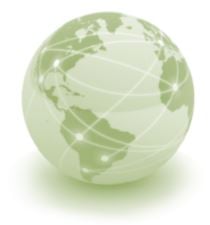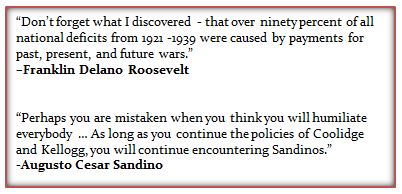U.S. interwar intervention existed around the globe. In Latin America, U.S. exercised power in Mexico (1910-1920), the Dominican Republic (1916-1924), Cuba (1917-1933), Guatemala (1920), Honduras (1919, 1924, 1925), Panama (1918- 1920, 1925), Nicaragua (1927 – 1932), El Salvador (1932), and Haiti (1915-1934). In Europe, the U.S. intervened in Russia (1918-1922), Yugoslavia (1919), and Turkey (1922). In Asia, U.S. foreign policy with China included intervention between 1922-1934, and in the Philippines from 1898 -1946. Whether defined as militaristic, political, economic, or cultural, U.S. intervention was the norm, not the exception, in the 1920’s and 1930’s. Despite these events, the narrative of U.S. Isolationism persists in high school textbooks and curriculum standards including the AP and IB programs.
Essential Questions:
- How is isolationism explained? Is it a valid claim?
- What are the limits of the isolation/intervention duality?
- To what extent can a global power be isolationist?
- What are the implied goals of a national narrative promoting isolationism?
Module Resources:
- Scholar Presentation Slides, by Gregg Brazinsky
- Myth of Isolationism Scholar Presentation (click title to download powerpoint slides)
- “On the whole, the 1920’s were not really a time of isolationism but of American economic and cultural engagement with the rest of the world. It was really the Great Depression, which brought an end to this. As other nations of the globe started to suffer economically, promoting American exports became a futile task. Economic conflicts emerged and these conflicts in turn would slowly lead to political conflicts by the mid-1930’s. “
- Supplemental Powerpoint Presentation: The Myth of Isolationism (click title to download powerpoint slides) This link takes you to TES resources. Download slides there. It has been used in a high school US History class.
- C3 Inquiry Lesson
- Secondary Sources/Informational Texts
- William Appleman Williams, The Legend of Isolationism in the 1920’s, Science and Society Winter (1954).
- This video is a compilation of two segments from the John Pilger documentary, Nicaragua: A Nation’s Right to Survive. It concentrates on Nicaragua up to the Sandinista Revolution, but also provides a chronicle of U.S. interventions in Latin America (1983).
- At 83, the last Marine in Nicaragua still has the enemy within his sights (1992)
- TIME Magazine: Finding the King’s Fortune! California Drill #7 Finds Oil in Saudi Arabia (2003).
- Mary Renda, Book Review by Kate Ramsey of Taking Haiti: Military Occupation & Culture of U.S. Imperialism 1915-1940 (2006).
- Dennis Merrill Publication, Book Review by Liza Keanuenueokalani Williams of Negotiating Paradise: U.S. Tourism and Empire in Twentieth Century Latin America, (2009).
- Bear F. Braumoeller, The Myth of American Isolationism, Foreign Policy Analysis (2010).
- Hilde Restad, U.S Foreign Policy Traditions since 1776 (2010).
- Chase Madar, Ostrich America: The ludicrous, destructive, curiously enduring myth of U.S. isolationism. (2010)
- Imagining Haiti: Representations of Haiti in the American Press during the U.S. Occupation,
1915-1934, paper (2011) - Frontline Film: Firestone and the Warlord (2014) Parts reference 1930s
- When America Occupied Haiti, podcast (2015)
- John Kealing et al American’s Had a Front Row Seat to Spain’s 20th Century Civil War (2016)
- The Polar Bear Expedition: America’s Involvement in Russia’s Civil War, video (2017)
- The Fiction of US Isolationism, by Andrew Bacevich (2017)
- Primary Sources
- Photo – A U.S. Marine inspecting a troop of Haitian soldiers. Credit U.S. Marine Corps/National Geographic Society, via Corbis (1920).
- “Declaration of the Rights of the Negro Peoples of the World”: The Principles of the Universal Negro Improvement Association; Marcus Garvey (1920)
- Video Footage, US Marines in Nicaragua 1920s. 8 minutes
- Soviet appeal to Washington D.C. for Famine Relief (1921).
- Newspaper Report Dominican Republic- The accounts were originally published in El Cable newspaper from San Juan de la Maguana Province. (1922)
- Treaty involving the United of States of America, Belgium, the British Empire, China, France, Italy, Japan, the Netherlands, and Portugal. Signed in Washington D.C. (1922).
- Photo – US Marines in Haiti attempt to win heart and minds, in a photo from John Alexander Hammerton’s Peoples Of All Nations: Their Life Today And Story Of Their Past (1922).
- Cartoon – Tacna-Arica arbitration agreement, Chile-Peru. The US attempted to facilitate the treaty (1922). LOC info is here.
- American Relief Administration film, selected clips “America’s Gift to Famine Stricken Russia,” (1923).
- Philippines Request Independence The Register, originally the South Australian Gazette and Colonial Register, South Australian newspaper. (1923).
- Augusto Cesar Sandino, An Open Letter to Presidents Hoover (1926).
- Women’s International League for Peace and Freedom, Conclusions and Recommendations by the Committee of Six Disinterested Americans (1926).
- Speech – President Calvin Coolidge addresses the the Pan American Conference at Havana, Cuba (1928).
- Visual History of Saudi Aramco (1930s)
- First Lady Eleanor Roosevelt with the Trujillos (1934)
- USMC Major General Smedley D. Butler, War is a Racket (1935).
- U.S. Secretary of State Cordell Hull and Rafael Trujillo, dictator of the Dominican Republic, signing the Hull-Trujillo Treaty (1940).





Thank you, this is a good summer resource to review for updating a curriculum